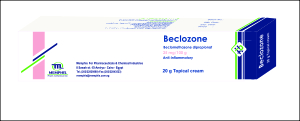Topical Cream 1 NAME OF THE MEDICINAL PRODUCT Beclozone 2 QUALITATIVE AND QUANTITATIVE COMPOSITION Each gram of cream contains 0.25 mg beclometasone dipropionate micronized Excipients with known effect: Each gram of cream contains 50 mg of Propylene Glycol. For the full list of excipients, see section 6.1. 3 PHARMACEUTICAL FORM Topical Cream. White smooth homogenous cream, free from lumps and foreign matter. 4 CLINICAL PARTICULARS 4.1 Therapeutic indications Beclozone Cream is indicated for the treatment of the various forms of eczema in children and adults including atopic and discoid eczemas; primary irritant and allergic dermatitis; psoriasis (excluding widespread plaque psoriasis); neurodermatoses including lichen simplex; intertrigo; discoid lupus erythematosus. The cream is often appropriate for moist or weeping surfaces and the ointment for dry, lichenified or scaly lesions but this is not invariably so. 4.2 Posology and method of administration Posology Beclozone Cream should be applied thinly over the whole of the affected area and gently rubbed in. Initially, application should be made twice daily, but when improvement is seen, the intervals between applications may be extended and treatment eventually stopped. If no improvement is seen within two to four weeks, reassessment of the diagnosis, or referral may be necessary. After cessation of treatment, should the condition recur, twice daily treatment should be re-instituted. However, when improvement is seen again, the intervals between applications may be gradually extended until maintenance dosing of application every third or fourth day is achieved. This is likely to avoid subsequent reappearance of the condition. The beneficial effects may be enhanced by preliminary use of hot soaks, or by intermittent applications or occlusive dressings. Method of administration For topical administration 4.3 Contraindications Hypersensitivity to the active substance or to any of the excipients listed in section 6.1. The cream should not be applied to the eyes. Rosacea, acne vulgaris; perioral dermatitis. Primary cutaneous viral infections (e.g. herpex simplex, chickenpox). Hypersensitivity to the preparation. Varicose ulcers or any other stasis ulcers. Use of Beclozone Cream is not indicated in the treatment of primarily infected skin lesions caused by infection with fungi (e.g. candidiasis, tinea) or bacteria (e.g. impetigo); primary or secondary infections due to yeasts; perianal and genital pruritus; dermatoses in children under 1 year of age, including dermatitis and napkin eruptions. 4.4 Special warnings and precautions for use Long-term continuous therapy should be avoided where possible, particularly in infants and children, as adrenal suppression can occur even without occlusion. The face, more than other areas of the body, may exhibit atrophic changes after prolonged treatment with potent topical corticosteroids. This must be borne in mind when treating such conditions as psoriasis, discoid lupus erythematosus and severe eczema. If applied to the eyelids, care is needed to ensure that the preparation does not enter the eye, as glaucoma might result. If used in childhood, or on the face, courses should be limited if possible to five days and occlusion should not be used. Topical corticosteroids may be hazardous in psoriasis for a number of reasons including rebound relapses, development of tolerance, risk of generalised pustular psoriasis and development of local or systemic toxicity due to impaired barrier function of the skin. If used in psoriasis careful patient supervision is important. Long term continuous or inappropriate use of topical steroids can result in the development of rebound flares after stopping treatment (topical steroid withdrawal syndrome). A severe form of rebound flare can develop which takes the form of a dermatitis with intense redness, stinging and burning that can spread beyond the initial treatment area. It is more likely to occur when delicate skin sites such as the face and flexures are treated. Should there be a reoccurrence of the condition within days to weeks after successful treatment a withdrawal reaction should be suspected. Reapplication should be with caution and specialist advise is recommended in these cases or other treatment options should be considered. Appropriate antimicrobial therapy should be used whenever treating inflammatory lesions which have become infected. Any spread of infection requires withdrawal of topical corticosteroid therapy and systemic administration of antimicrobial agents. Bacterial infection is encouraged by the warm, moist conditions induced by occlusive dressings, and so the skin should be cleansed before a fresh dressing is applied. Fire hazard in contact with dressings, clothing and bedding Instruct patients not to smoke or go near naked flames - risk of severe burns. Fabric (clothing, bedding, dressings etc) that has been in contact with this product burns more easily and is a serious fire hazard. Washing clothing and bedding may reduce product build-up but not totally remove it.
